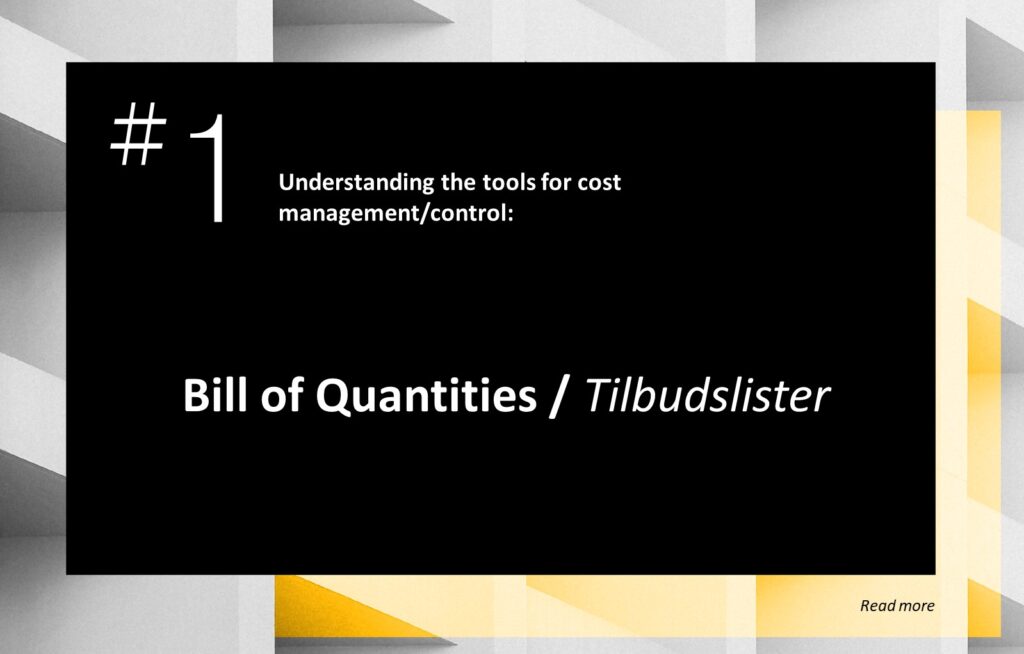How Modern Methods of Construction can deliver greater Cost Certainty and Overall Value
A Quantity Surveyors Contribution
You can download the presentation bellow:
You can download the presentation bellow:
| Almost more important than a good process for commercial management, are the tools implemented in the project to carry on this task. The most used tool for this purpose would be a standardized Bill of Quantities. The main purpose of a bill of quantities (BoQ) is to present a coordinated list of components/items, together with their identifying descriptions and quantities that encompass the building works, so that the tendering contractors are able to prepare tenders efficiently and accurately. Having a standardized BoQ will assure parity of tendering, as all bidders will base their offers on the same conditions and contents. For a quantity surveyor/cost manager, the BoQ becames a vital tool, as it will be used to manage and control the costs of the building project. Cost management and control uses include: |

As Quantity Surveyors, we have experienced a change in the perception of our profession in the Danish construction industry. But… how will this continue changing in the coming years?
Join us in LinkedIn and become a follower of the latest news around commercial managements and quantity surveying.
https://www.linkedin.com/company/kosmos-dk
In the video below, Ross Griffin, from KOSMOS (www.kosmosdk.com) talks in this video about how the perception of Quantity Surveying in Danish Construction has changed in the last years.
KOSMOS is celebrating Green Friday every day. We have joined the movement of change and solution oriented deliveries. This week , we are promoting solutions that we offer to the construction industry, to achieve greener, cleaner, better environmentally performing and more sustainable solutions often discarded on projects due to their apparent capital cost, but what about the circular cost benefits.
There is a better way of doing things, and we are determined to assist with our professional knowledge to achieve this change in the industry.
So, how can we in KOSMOS help construction projects to make this turn? Quantity surveyors can bring their commercial knowledge to projects in order to:
Having a solid idea of the actual project costs, allows to distribute the budget in a more optimal and efficient way. This brings the possibility of implementing green solutions, better environmental performance systems, sustainable and clean materials that would have otherwise been considered a luxury or a risk for the overall project economy due to its higher cost.
The potential time extension of the execution or the design when implementing new solutions can be assessed and estimated, so that a decision of whether or not taking those greener alternatives into the project can be taken based on facts and acknowledging the consequences. The values gained by circular economic investigations can have a great impact on the projects lifecycle and OPEX costs.
Better control of the project economy prevents cost overruns. A project with a solid economy won’t have surprises in the late stages, when cost reductions are mostly limited to reduction of quality, and replacing sustainable solutions for alternative less capitally expensive ones.
It is possible to determine the cost of more durable alternatives, and the return of investment of it. Having this analysis, it is possible to enlarge the life of the product chosen in the design, not focusing this choice purely on its initial capital costs. Incorporating alternative models of procurement can also reduce initial capital expenses and transfer these costs into the operations over a longer period through supply, maintain and replace contracts.
Looking at products and materials from cross-industry perspective. Waste in one industry or one project could be a supply source in other industry or project. This helps to reduce cost of disposal, supply, CO2 emission, and to optimize the lifespan of products.

It requires great effort, to assimilate data collection as a regular practice, to comprehend the value of that data, and to consider it not as a waste of time but the most valuable investment a company can make. Once this is decided upon and a strong standard is established to allow this process to be an automatic task, a company has a TREASURE!
One of the most common reasons for project costs overruns we repeatedly encounter on projects during the design phases, are due to REWORK.
Rework may happen inevitably on small portions, however, we believe that major redesign can be avoided by having a good planning, in order to mitigate most of the following reasons:
They all not only affect the project time schedule by causing delays, but they also have an impact on the overall project economy and the quality output.

A good quality of the design when tendering, from a Commercial perspective, will: